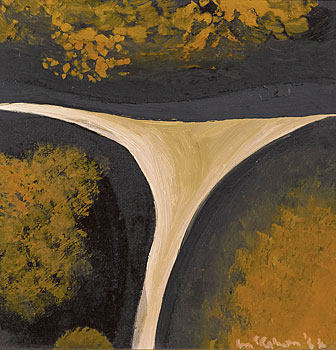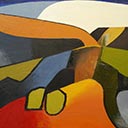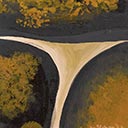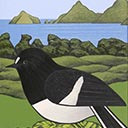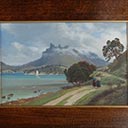Waterfall
21.2 x 21.4 cm
est. $25,000 - 40,000
PROVENANCE
Ex Collection of Dr Ursula Hoff AO OBE, Melbourne. Australian scholar, academic, curator, writer, critic, and lecturer; Deputy Director of the National Gallery of Victoria, Melbourne (1968-1973); London Adviser of the Felton Bequest (1975-83); author of numerous books, catalogues, articles, reviews, and scholarly publications on art.
Sotheby's, Australian & International Fine Art, Melbourne, 20/04/2010
Savill Galleries, NSW label affixed verso
EXHIBITED
Small Landscapes and Waterfalls , Eric Scholes Gallery, Rotorua, 1964
Small Landscapes and Waterfalls , Ikon Fine Arts, Auckland, 1964
REFERENCE
Colin McCahon online database cm001473
Light and timelessness. Face-to-face with Colin McCahon's beautiful 1964 Waterfall painting, these two enduring qualities radiate and instil a sense of otherworldliness; one which contradicts the evasive and fleeting nature of water falling. There is a potency and ethereal gracefulness to this work which, when experienced firsthand, packs a powerful punch. Considering the work, the viewer's eye is immediately drawn to the waterfall. Smooth and fluid brushstrokes guide its downwards trajectory, the form assumed resembling the primal 'T' of the Egyptian cross (this being a reoccurring visual device in a much of McCahon's work) and subtle tonal variations illuminating the waterfall. Earthy, ochre tones give Waterfall a grittiness which challenges any idealised, traditionally picturesque qualities we may have otherwise been tempted to ascribe to, or expect from the depiction of a waterfall.
The significance of what Waterfall stands to represent in the wider scheme of McCahon's artistic identity is twofold. Firstly, there is the close relationship and spiritual connection with New Zealand's natural landscape - the Fairy Falls in the Waitakere Ranges inspired this painting and formed the basis for McCahon's pure process of artistic distillation in this instance. Secondly, the work's abstracted formal qualities mark his connection to the global art movement, and unique take on the tradition of Abstract Expressionism. Following his trip to the United States in 1958, McCahon afforded a new and careful attention to the relationship between canvas, colour, and form, and ultimately came to re-evaluate the act of painting in and of itself. The impact of this approach is clearly perceivable in Waterfall: primal, elemental colours and forms have propelled the painted canvas into such a degree of abstraction that the originally conceived landscape is almost completely opaque, and the viewer is left in something of a spiritual no-man's land.
McCahon's Waterfall is a supreme exercise in abstraction, one which prompts us to re-examine our relationship with the land through transforming it into a work of Old Testament-style gravity and fortitude. These words of McCahon's offer a poetic accompaniment by way of conclusion "Waterfalls fell and raged and became as still silent falls of light for a long time".

